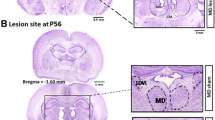Summary
New Zealand Black (NZB) mice were suggested as an animal model for human dementia. We performed quantitative and cytoarchitectural studies of the entorhinal region and the hippocampus of 10 NZB mice and compared the results with those for a control group of 10 Carworth Farm Webster (CFW) mice.
No cytoarchitectural disturbances were observed in the entorhinal cortex and hippocampus of the NZB mice. We, however, found a reduced density of nerve cells in the entorhinal region as well as in the CA1 and CA3 regions of the Ammon's horn in NZB mice.
Since the entorhinal region is an important link between sensory and association cortices and the limbic system which seems to play an important role in learning and memory, the present findings may be a cause of learning and/or memory deficits in the NZB mice.
The undisturbed cytoachitecture of the entorhinal cortex suggests that the reduced cell sensity in NZB mice is rather an acquired lesion than a developmental malformation and, therefore, indicates therapeutic studies on memory and learning deficits in NZB mice.
Similar content being viewed by others
References
Barbizet J (1963) Defect of memorizing of hippocampal-mammillary origin: a review. J Neurol Neurosurg Psychiatry 26: 127–135
Blackstad TW (1956) Commisural connections of the hippocampal region in the rat, with special reference to their mode of termination. J Comp Neurol 105: 417–537
Caviness VS jr., Sidman RL (1973) Retrohippocampal, hippocampal and related structures of the forebrain in the reeler mutant mouse. J Comp Neurol 147: 235–253
Haug FMS (1976) Sulphide silver pattern and cytoarchitectonics of parahippocampal areas in the rat. Special reference to the subdivision of area entorhinalis (area 28) and its demarcation from the pyriform cortex. Springer, Berlin Heidelberg New York
Hjorth-Simonsen A (1972) Projection of the lateral part of the entorhinal are to the hippocampus and fascia dentata. J Comp Neurol 146: 219–232
Hjorth-Simonsen A, Jeune B (1972) Origin and termination of the hippocampal perfornat path in the rat studied by silver impregnation. J Comp Neurol 144: 215–232
Hoffman SA, Hoffmann AA, Shucard BW, Harbeck RJ (1978) Antibodies to dissociated cerebellar cells in New Zealand Mice as demonstrated by immuno fluorescence. Brain Res 152: 477–486
Howie JB, Helyer BJ (1968) The immunology and pathology of NZB mice. Adv Immunol 9: 215–255
Krieg WJS (1946) Connection of the cerebral cortex. I The albino rat. A topography of the cortical areas. J Comp Neurol 84: 221–275
Lal H, Forster MJ, Nandy K (1985) Immunologic factors related to cognitive/behavioral dysfunctions in aging. In: Traber J, Gipsen WH (eds) Senile dementia of the Alzheimer type. Springer, Berlin Heidelberg New York Tokyo, pp 343–354
Lorente de Nó R (1933) Studies on the structure of the cerebral cortex. J Psychol Neurol 45: 381–138
Mc Naughton (1980) Evidence for two physiologically distinct perforant pathways to the fascia dentata. Brain Res 199: 1–19
Meissner WW (1966) Hippocampal functions in learning. J Psychiatr Res 4: 235–304
Milner B (1972) Disorders of learning and memory after temporal lobe lesions in man. Clin Neurosurg 19: 421–446
Nandy K (1978) Brain-reactive antibodies in aging and senile dementia and related disorders. In: Katzman R, Terry RD, Bick K (eds) Alzheimers dementia-senile dementia and related disorders. Raven Press, New York, pp 503–512
Nandy K, Lal H, Bennett M, Bennett D (1983) Correlation between a learning disorders and elevated brain-reactive antibodies in aged C57BL/6 and young NZB mice. Life Sci 33: 1499–1503
Nafstad PHJ (1967) An electron microscope study on the termination of the perforant path fibres in the hippocampus and the fascia dentata. Z Zellforsch 76: 532–542
Penfield W, Mathieson G (1974) Memory autopsy findings and comments on the role of hippocampus in experimental recall. Arch Neurol 31: 145–154
Schwerdtfeger WK (1984) Structure and fiber connections of the hippocampus. Springer, Berlin Heidelberg New York Tokyo
Segal M, Landis S (1974) Afferents to the hippocampus of the rats studied with the method of retrograde transport of horseradish peroxidase. Brain Res 78: 1–15
Spencer DG, Humphries K, Mathis D, Lal H (1987) Behavioral impairments related to cognitive dysfunction in the autoimmune New Zealand Black Mouse. Behav Neurosci (in press)
Stephan H (1975) Allocortex. In: Bargmann W (ed) Nervensystem. Handbuch der mikroskopischen Anatomie des Menschen, Bd IV/9. Springer, Berlin Heidelberg New York
Steward O, Scoville SA (1976) Cells of origin of the entorhinal cortical afferents to the hippocampus and fascia dentata of the rat. J Comp Neurol 169: 347–370
Rose M (1929) Cytoarchitektonischer Atlas der Großhirnrinde der Maus. J Psychol Neurol 40: 1–51
Van Hoesen GW, Pandya DN (1971) Projections from the parahippocampal area to the hippocampus in the rhesus monkey. Anat Rec 169: 445
Van Hoesen GW, Pandya DN, Bitters N (1972) Cortical afferents to the enthorinal cortex of the rhesus monkey. Science 175: 1471–1473
Vaz Ferreira A (1951) The cortical areas of the albino rat studied by silver impregnation. J Comp Neurol 95: 177–243
Walker SE (1982) Prolonged lifespans in female NZB/NZW mice treated with the experimental immunoregulatory drug frentizole. Arthritis Rheum 25: 1291–1297
Weibel ER (1979) Stereological methods, vol 1. Acàdemic Press, London New York, p 47
Witter MP, Room P, Groenemeyer HJ, Lohmann HM (1986) Connections of the parahippocampal cortex in the cat. V. Intrinsic connections; comments on input/output connections with the hippocampus. J Comp Neurol 252: 78–94
Zilles K (1985) Morphological studies on brain structures of the NZB mouse: an animal model for the aging human brain? In: Traber J, Gispen WH (eds) Senile dementia of the Alzheimer type. Springer, Berlin Heidelberg New York Tokyo, pp 355–365
Author information
Authors and Affiliations
Rights and permissions
About this article
Cite this article
Anstätt, T. Quantitative and cytoarchitectural studies of the entorhinal region and the hippocampus of New Zealand Black mice. J. Neural Transmission 73, 249–257 (1988). https://doi.org/10.1007/BF01250140
Received:
Accepted:
Issue Date:
DOI: https://doi.org/10.1007/BF01250140



